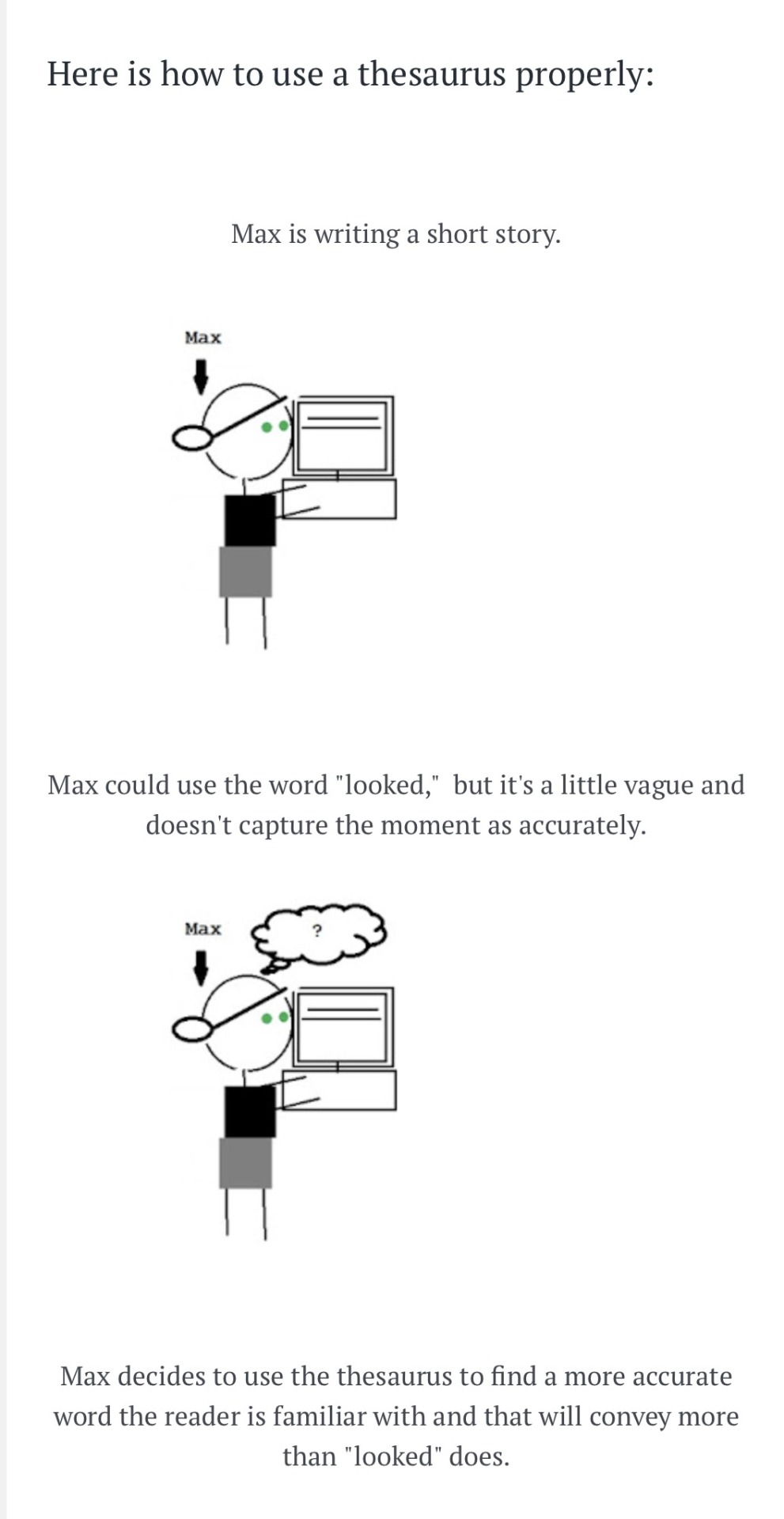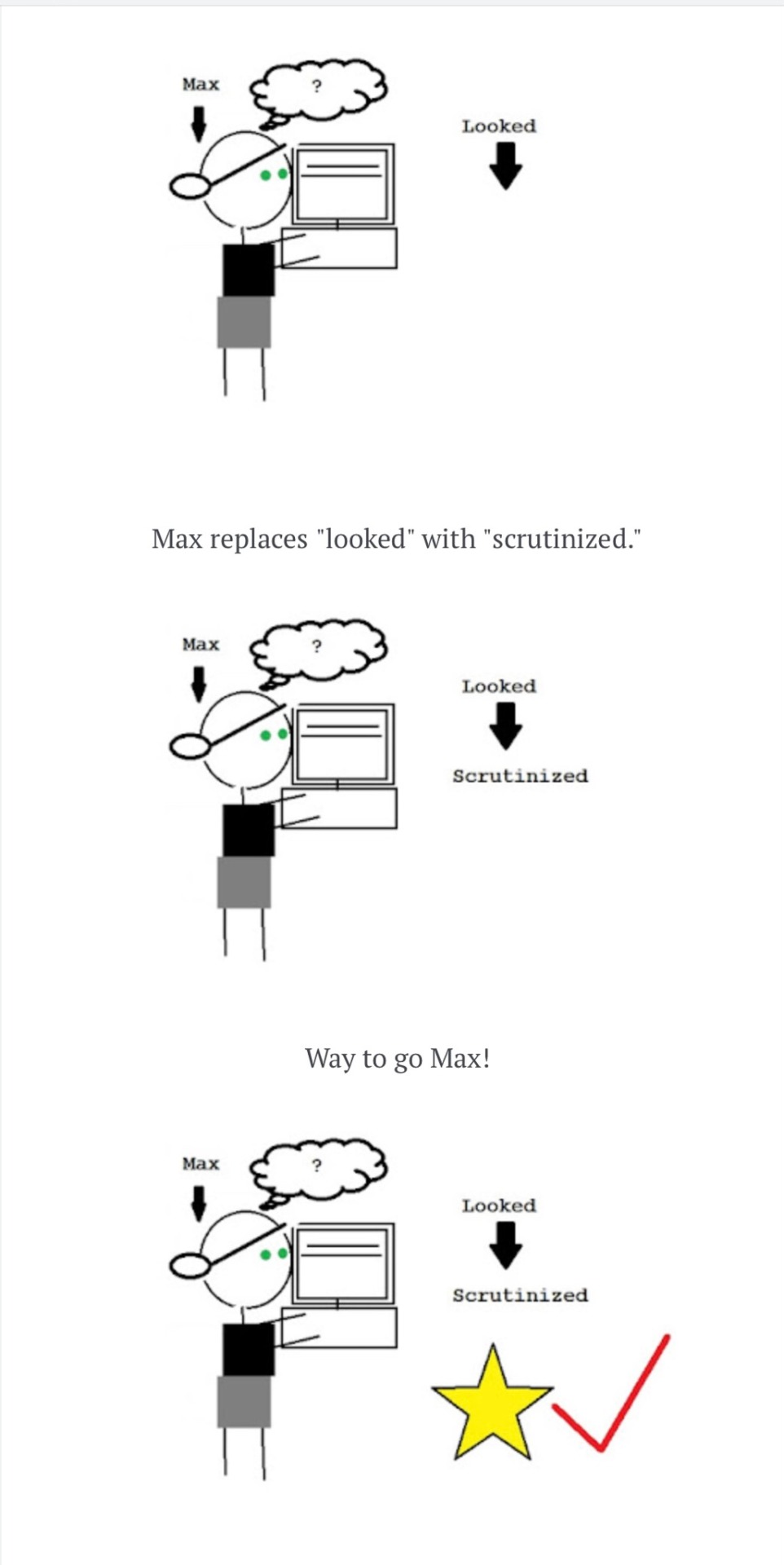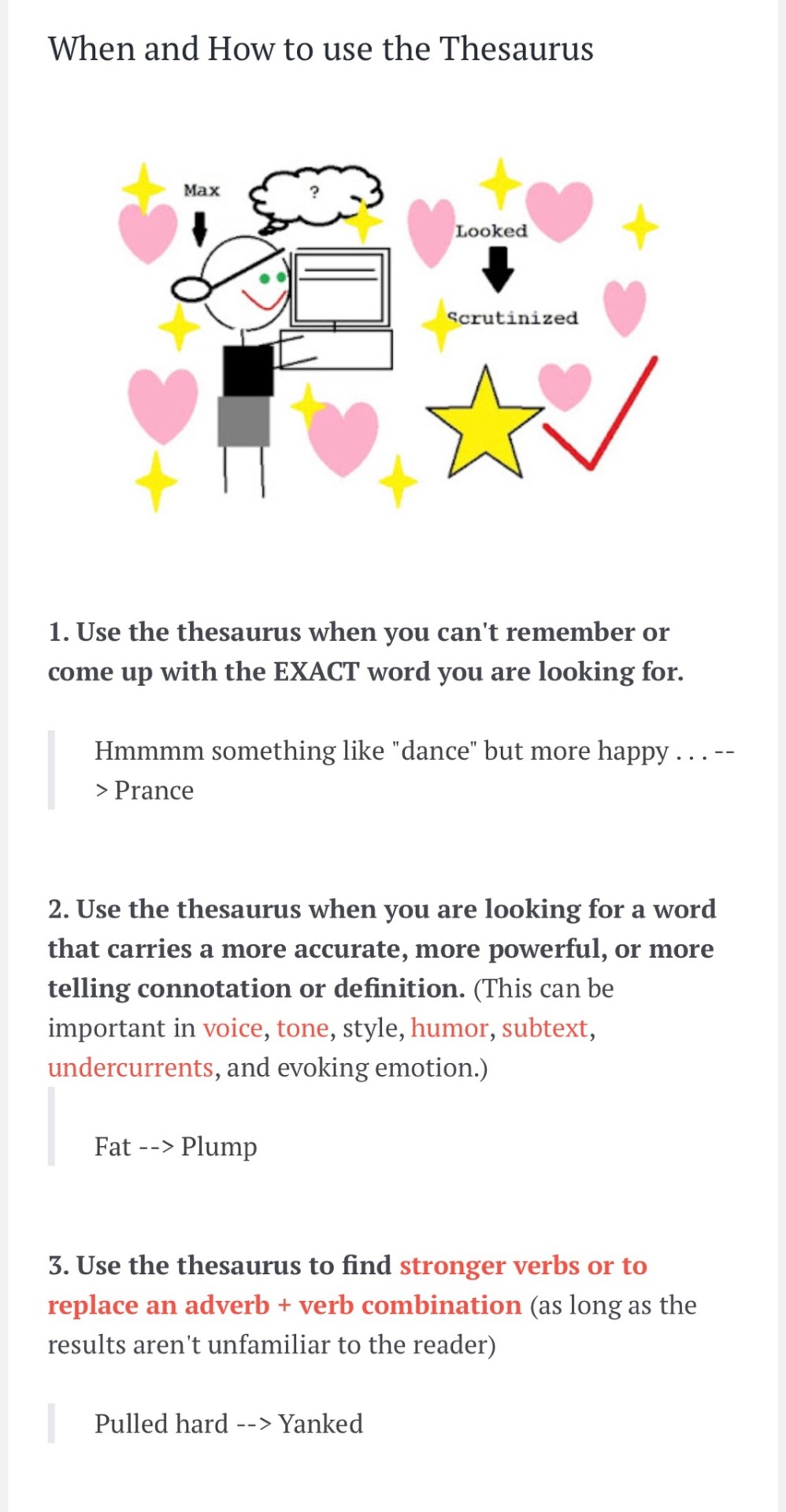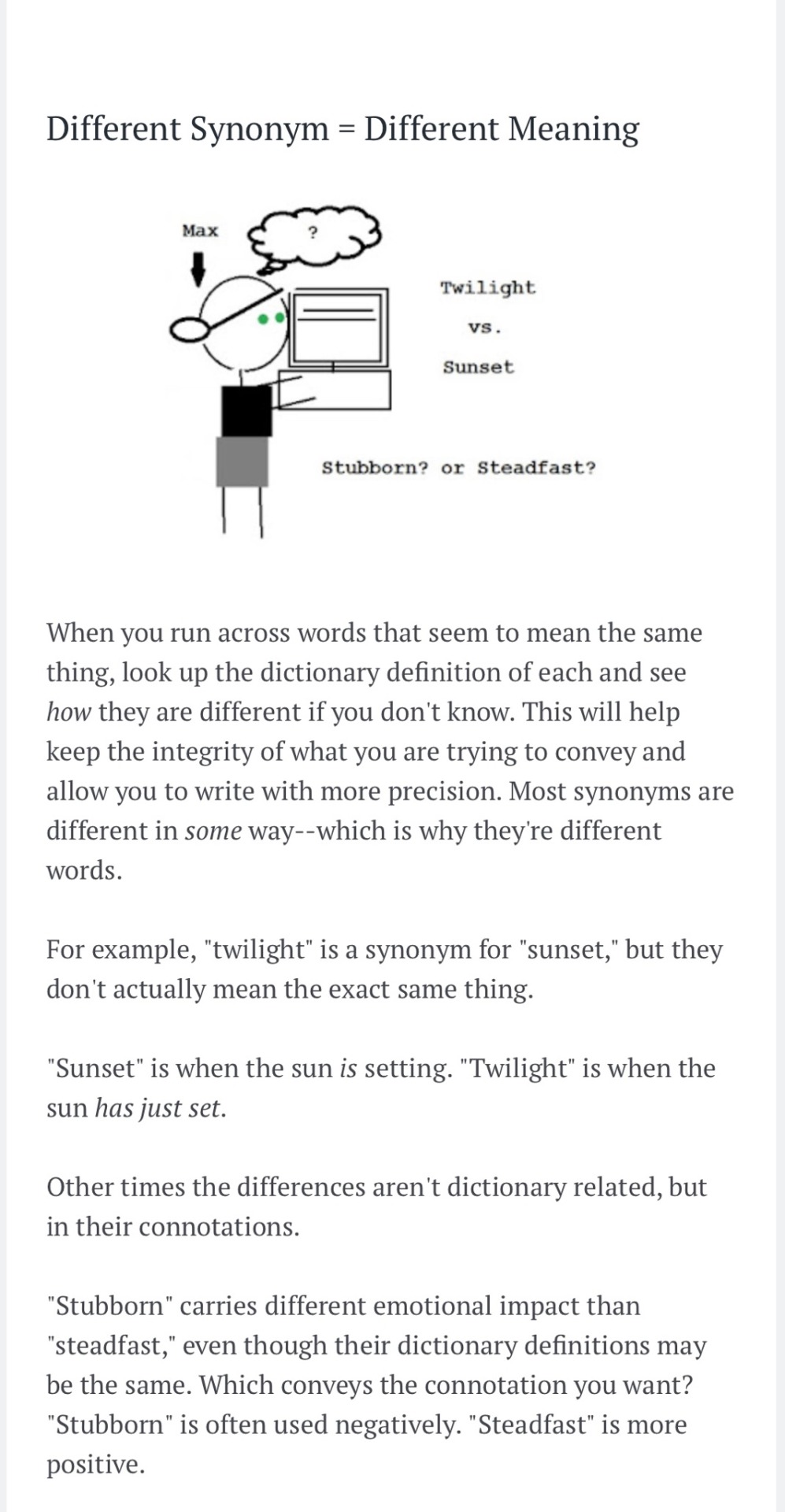A Messy Dream. Literally Messy
A messy Dream. Literally messy

More Posts from Xlili-lyraterx and Others

Write your name on my skin.
Six Sexy Words





I hate to say this, and like, rain on everyone’s parade, but after scrolling past three posts about it on a writing tag …
If you are looking up synonyms to exchange words out in your story with the purpose of sounding smarter, more sophisticated, or complicated to your reader, you are probably abusing the thesaurus.
Now, if you *want* to do this, I mean, you can write whatever or however you want! But I just want you to know that this is frowned upon if you are trying to write at a professional level.
I have an old article on this somewhere …







If you want to look at the original article…
https://www.septembercfawkes.com/2018/08/how-to-use-thesaurus-properly.html

📝 Emotion, atmosphere and environment: A writing exercise for show-don't-tell
Before we go any further, I want to make it clear that I'm not aggressively against telling. Sometimes telling works for a whole bunch of valid reasons. If you know me at all, you'll be aware of where I stand on the issue of narrow, prescriptive writing rules (if you don't know me, hi, I despise narrow, prescriptive writing rules)
But "How do I show instead of telling?" is still a thing a lot of newer writers have difficulty with and that's what I'd like to dig into. So here's a writing exercise you could try to help build depth and atmosphere around the emotion your character is feeling...

🧠 First of all, pick an emotional experience.
For illustrative purposes, I'm going with LOSS. Then express that emotional experience in ways that can be perceived physically. The following are just suggestions, not an exhaustive list.
🎨 How could the emotion be expressed as a colour?
Grey, maybe. Slate grey. Or a muted petrol blue, perhaps.
🔊 How could the emotion be expressed as a sound?
Deep silence interrupted only by the sound of a ticking clock.
👋 How could the emotion be expressed as a physical action?
Your hand reaching to grasp for comfort out of habit and hope, fingers curling around something remembered, then dropping back to the coldness of the other side of the bed, empty.
🌄 How could the emotion be expressed as a weather condition or natural phenomenon?
The storm passed an hour ago, leaving only an occasional flurry of sleet that melts on contact with the window, sliding down the glass like tears. Outside, a tree that shed its leaves in autumn bows in tired silhouette against the halo of a single streetlight.
🏡 How could the emotion be expressed as a room?
Your nightstand holds the bottle of water you filled before trudging upstairs at midnight, your phone still plugged in even though the battery was full three hours ago, and the glasses you'll put on again as soon as you wake up after sleep eventually manages to swallow you. The nightstand on the other side of the bed holds a small tear-off calendar showing November eighteenth even though it's now January second and a book lying open and face-down with the spine sinking into itself. In the corner of the room, there's a chair with clothes carelessly draped over it a month and a half ago that you still can't bring yourself to put in the laundry. It's four o'clock in the morning and you'd give anything to hear breathing that wasn't your own.

You could try it for different emotions and different situations, in isolation and then connected to something you're in the process of writing.
How could anger, for example, be expressed differently in an office environment compared to a wilderness landscape? How could joy be shown in summer versus winter? How could fear be embodied in high fantasy compared to cyberpunk?
If relating environments to emotions doesn't click for you straight away, could you focus on single-sense experiences for a while? What colour is regret? What does anticipation taste like?
If you have synesthesia (hello, fellow synesthetes!) this could be a wild ride, but hopefully it'll also be fun and useful for anyone having difficulty connecting to the idea of show-don't-tell.
Happy writing! 💜
Few are the things more enticing, and at once terrifying, than a hand held out in invitation, when the mouth smiling at you bares fangs.

new ask meme! anonymously assign me a vibe
Circling vs. Zigzagging Conflicts

Nearly every writer understands that a story needs conflict. The protagonist sets off to fulfill a goal, runs into an antagonistic force, and their struggle creates conflict. This should happen in the story as a whole, this should happen in acts, and it should happen in almost every scene--the difference is that the smaller the structural unit, the smaller the antagonist and conflict (simplistically speaking).
Today I want to talk about a sneaky problem I sometimes see when editing manuscripts, one that relates to conflicts.
Sometimes the writer simply “circles” the conflict.
What I mean is that after a given conflict, nothing has actually changed in the story. We just completed a “circle.”
For example, say the protagonist is a favorite target of the schoolyard bully. They get into a verbal fight, but when it's over, nothing's different. The conflict didn't have any consequences.
It may not sound that bad.
And if it only happens once in a while, and there are enough other conflicts going on, it may not be.
But if this happens repeatedly or this is the main conflict, the plot isn't progressing. It just did a circle and the characters ended up in the same situation they were before the encounter. Essentially, no matter how exciting the scene may seem to be, you could still cut it and the story would be the same.
Let's look at an even less obvious example.
The protagonist needs to get Object X from Character B.
The protagonist finds a way to successfully steal it.
But then immediately afterward, Character B steals it back.
The scene ends, and the protagonist is back at square one.
It doesn't sound that bad, does it?
And if it only happens once in a while, and there are enough other conflicts going on, it may not be.
But if this sort of thing happens repeatedly--over and over and over--the plot isn't progressing. You're just going back and forth and back and forth and back and forth. And if we just arc that path a bit, guess what? It creates a circle.

Another example:
The protagonist has a problem.
But she's not taking action to solve the problem.
Yes, she reacts emotionally to the problem.
She may even sometimes come up with a plan for how to try to solve the problem.
But she doesn't execute it. Or, some other problem comes up that keeps her from executing it.
And rather than come up with and execute a new plan to address that problem.
She just reacts emotionally to the problem.
Imagine this going on for multiple scenes.
The plot isn't progressing. She's just ruminating.
It still feels like the text is just circling the conflict.
Please know I'm not saying a story can never do these things. On rare occasions, circling conflicts can be useful, like when the point is to show the audience how some things don't change. My first example may arguably work near the beginning of the story, to show what the protagonist's day-to-day life is like. My second example can sometimes work as a frustrating irony. And my last example, well . . . don't do my last example. Okay, okay, maybe it could work to show off how the protagonist is incapable of or has the flaw of never moving forward (and chances are it'd probably be better to illustrate that through summary, rather than scene).
And some degree of circling can work, when the story needs to end with the characters and world in the same place they started, like in a serial, but note that usually through the installment, there isn't much circling.
And often, even if the external circumstances complete a circle, the journey changed the character internally in some significant way.
BUT if you are repeatedly writing examples like those above, where the situation at the end of a scene or act is essentially the same as it was at the beginning of the scene or act, then you aren't moving the story forward.

Sure, conflict may show up on the page, but the text is just circling it.
Instead, it's much more effective to create a zigzag.
If we wanted to keep this super simple, we might say the scene (or act) needs to move from a positive situation to a negative situation, or a negative situation to a positive situation. Or, a positive situation to a better situation, or a negative situation to a worse situation. Essentially:
+ --> -
- --> +
+ --> ++
- --> --
This is a good starting point, but I admit, it sometimes feels oversimplified to me.
In any case, the situation the character is in, has changed.
The story didn't do a circle. It did a zigzag (or zigzigger or zagzagger).
The protagonist had a goal, encountered an antagonist, had a conflict, and the conflict came to a definitive outcome (if only on the small scale for that scene). It hit a climax or turning point.
And that outcome carries consequences.
The protagonist gets in an argument with the bully and gets suspended for his language. If he's suspended, his parents will ground him, and he won't get to go on an upcoming date with his crush. It's a setback.
Character B steals Object X back and in the process, mortally wounds the protagonist. Now the protagonist needs to get help before they die.
The protagonist takes action to solve the new problem, and not only succeeds, but manages to solve her original problem at the same time.

But often just adding consequences isn't enough. We need to make sure the consequences aren't or can't be undone, at least not easily or coincidentally. We don't have the protagonist's dad have a serendipitous change of heart and simply allow the protagonist to go on the date.
Don't undo what you just did (generally speaking).
If the protagonist ended with a bigger or new problem, make him put in the effort to try to solve it. (See the "No, and . . ." vs. "Yes, but . . . " rule under "Disaster.")
And don't forget my "acid test" for plot progression. At the end of the scene (or act), ask, did the protagonist's current goal and/or plan shift? If the answer is no, chances are you did a circle. (Or you at least left things stagnating). If the answer is yes, something changed.
As I mentioned above, sometimes the change is internal.
Maybe Character B did simply steal Object X back, but maybe that leads to the protagonist realizing he doesn't want Object X as much as he wants revenge on Character B. He hatches a plan to exact that.
While that may not be as strong as the protagonist getting mortally wounded, it's better than nothing changing, and the experience does change the direction of the story.
Personally, I'd still be cautious of writing such a situation, though. In most types of stories, we want consequences to be both internal and external.
But that topic could be another post.
So in closing: zigzagging conflicts is better than circling them.
Adieu.
-
 cool-ttgaming-love liked this · 8 months ago
cool-ttgaming-love liked this · 8 months ago -
 mommymayi-iwillanyway reblogged this · 10 months ago
mommymayi-iwillanyway reblogged this · 10 months ago -
 hahnwhejsj liked this · 10 months ago
hahnwhejsj liked this · 10 months ago -
 typical-soup liked this · 11 months ago
typical-soup liked this · 11 months ago -
 alohdark reblogged this · 11 months ago
alohdark reblogged this · 11 months ago -
 mid0khan liked this · 11 months ago
mid0khan liked this · 11 months ago -
 reluctant1lady reblogged this · 11 months ago
reluctant1lady reblogged this · 11 months ago -
 kydrogendragon reblogged this · 11 months ago
kydrogendragon reblogged this · 11 months ago -
 sharpkittyteeth liked this · 1 year ago
sharpkittyteeth liked this · 1 year ago -
 messandahalf10 reblogged this · 1 year ago
messandahalf10 reblogged this · 1 year ago -
 messandahalf10 liked this · 1 year ago
messandahalf10 liked this · 1 year ago -
 jake-is-screaming-in-tune reblogged this · 1 year ago
jake-is-screaming-in-tune reblogged this · 1 year ago -
 cynthia-madeline reblogged this · 1 year ago
cynthia-madeline reblogged this · 1 year ago -
 kydrogendragon liked this · 1 year ago
kydrogendragon liked this · 1 year ago -
 tablewithfivelegs liked this · 1 year ago
tablewithfivelegs liked this · 1 year ago -
 rakenrollrobin liked this · 1 year ago
rakenrollrobin liked this · 1 year ago -
 dinalogos liked this · 1 year ago
dinalogos liked this · 1 year ago -
 ewintermoon25 liked this · 1 year ago
ewintermoon25 liked this · 1 year ago -
 pluckyyoungdonna reblogged this · 1 year ago
pluckyyoungdonna reblogged this · 1 year ago -
 caswatchesbees liked this · 1 year ago
caswatchesbees liked this · 1 year ago -
 dailydreamling reblogged this · 1 year ago
dailydreamling reblogged this · 1 year ago -
 sparklyfoxpizza liked this · 1 year ago
sparklyfoxpizza liked this · 1 year ago -
 silverstream2 reblogged this · 1 year ago
silverstream2 reblogged this · 1 year ago -
 redorbcentral liked this · 1 year ago
redorbcentral liked this · 1 year ago -
 athena125 liked this · 1 year ago
athena125 liked this · 1 year ago -
 uffadioboia liked this · 1 year ago
uffadioboia liked this · 1 year ago -
 warynerd liked this · 1 year ago
warynerd liked this · 1 year ago -
 warynerd reblogged this · 1 year ago
warynerd reblogged this · 1 year ago -
 orangehood liked this · 1 year ago
orangehood liked this · 1 year ago -
 deaniewithalittleweanie reblogged this · 1 year ago
deaniewithalittleweanie reblogged this · 1 year ago -
 whats-the-bi-fi-password liked this · 1 year ago
whats-the-bi-fi-password liked this · 1 year ago -
 alittleannihilati0n liked this · 1 year ago
alittleannihilati0n liked this · 1 year ago -
 cagedpencil liked this · 1 year ago
cagedpencil liked this · 1 year ago -
 novassketches liked this · 1 year ago
novassketches liked this · 1 year ago -
 abreathsecho liked this · 1 year ago
abreathsecho liked this · 1 year ago -
 abreathsecho reblogged this · 1 year ago
abreathsecho reblogged this · 1 year ago -
 deaniewithalittleweanie liked this · 1 year ago
deaniewithalittleweanie liked this · 1 year ago -
 duckiii liked this · 1 year ago
duckiii liked this · 1 year ago -
 thearoacemess liked this · 1 year ago
thearoacemess liked this · 1 year ago -
 shaniacsforthewinxx reblogged this · 1 year ago
shaniacsforthewinxx reblogged this · 1 year ago -
 shaniacsforthewinxx liked this · 1 year ago
shaniacsforthewinxx liked this · 1 year ago -
 fellshish reblogged this · 1 year ago
fellshish reblogged this · 1 year ago -
 fellshish liked this · 1 year ago
fellshish liked this · 1 year ago -
 ineffably-ryuu reblogged this · 1 year ago
ineffably-ryuu reblogged this · 1 year ago -
 barbaravitoriatp reblogged this · 1 year ago
barbaravitoriatp reblogged this · 1 year ago -
 may-darling reblogged this · 1 year ago
may-darling reblogged this · 1 year ago -
 grace-in-the-wilderness reblogged this · 1 year ago
grace-in-the-wilderness reblogged this · 1 year ago -
 grace-in-the-wilderness liked this · 1 year ago
grace-in-the-wilderness liked this · 1 year ago -
 ace-of-tales liked this · 1 year ago
ace-of-tales liked this · 1 year ago
